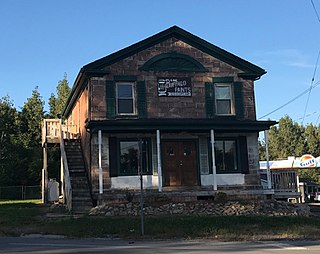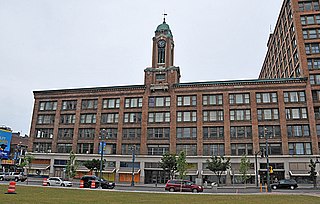
Brockport is a village in the Town of Sweden, with two tiny portions in the Town of Clarkson, in Monroe County, New York, United States. The population was 8,366 at the 2010 U.S. Census. The name is derived from Heil Brockway, an early settler. It is also home to the State University of New York (SUNY) at Brockport.

Rochester is a city in the U.S. state of New York, the seat of Monroe County, and the fourth-most populous in the state after New York City, Buffalo, and Yonkers with a population of 211,328 in 2020. The city of Rochester forms the core of a larger metropolitan area with a population of 1 million people, across six counties. The city was one of the United States' first boomtowns, initially due to the fertile Genesee River Valley, which gave rise to numerous flour mills, and then as a manufacturing center, which spurred further rapid population growth.

Pittsford is a village in Monroe County, New York, United States. The population was 1,355 at the 2010 census. It is named after Pittsford, Vermont, the native town of a founding father.

Pittsford is a town in Monroe County, New York, United States. A suburb of Rochester, its population was 30,617 at the 2020 census.

Gannett Co., Inc. is an American mass media holding company headquartered in McLean, Virginia, in the Washington, D.C., metropolitan area. It is the largest U.S. newspaper publisher as measured by total daily circulation.

The Democrat and Chronicle is a daily newspaper serving the greater Rochester, New York, area. At 245 East Main Street in downtown Rochester, the Democrat and Chronicle operates under the ownership of Gannett. The paper's production facility is in the town of Greece, New York. Since the Times-Union merger in 1997, the Democrat and Chronicle is Rochester's only daily circulated newspaper.

The Rochester Industrial and Rapid Transit Railway, more commonly known as the Rochester subway was a light rail rapid transit line in the city of Rochester, New York, from 1927 to 1956. The subway was constructed in the bed of the old Erie Canal, which allowed the route to be grade-separated for its entire length. Two miles (3.2 km) of the route through downtown were constructed in a cut-and-cover tunnel that became Broad Street, and the only underground portion of the subway. The Rochester Subway was designed to reduce interurban traffic on city streets, and to facilitate freight interchange between the railroads. The line was operated on a contract basis by New York State Railways until Rochester Transit Corporation (RTC) took over in 1938. The last day of passenger service was June 30, 1956. Portions of the right-of-way were used for expressway construction, while the rest was abandoned and filled in over the years. The largest remaining section is a stretch of tunnel under Broad Street from Exchange Street to the intersection of Court Street and South Avenue.

The New York State Canal System is a successor to the Erie Canal and other canals within New York. Currently, the 525-mile (845 km) system is composed of the Erie Canal, the Oswego Canal, the Cayuga–Seneca Canal, and the Champlain Canal. In 2014 the system was listed as a national historic district on the National Register of Historic Places in its entirety, and in 2016 it was designated a National Historic Landmark.

The George Eastman Museum, also referred to as George Eastman House, International Museum of Photography and Film, the world's oldest museum dedicated to photography and one of the world's oldest film archives, opened to the public in 1949 in Rochester, New York.

Valentown Hall is the name of an abandoned historic shopping and community center located in Victor, New York. The structure was built in 1879 by Levi Valentine, and today it is operated as a museum on the National Register of Historic Places.

Sibley, Lindsay & Curr Company, known informally as Sibley's, was a Rochester, New York-based department store chain with stores located exclusively in the state of New York. Its flagship store, at 228 East Main Street in downtown Rochester, also housed its headquarters and featured an elegant executive dining room on the top floor.

The Morgan–Manning House is a historic house located in Brockport, Monroe County, New York. It was built in 1854 and is a two-story, Italianate–style brick dwelling on a limestone foundation. The five-by-four-bay main block features a hipped roof and cupola. It has a two-story hipped roof wing with a smaller two-story brick appendage creating a stepped, or telescoping, plan or profile. The house also has a full width porch with brick piers. The interior features elaborate interior woodwork, period plasterwork, stained glass and decorated ceilings. Also on the property is a contributing carriage house.

Myron Holley was an American politician who had a large part in the construction of the Erie Canal.

Cobblestone architecture refers to the use of cobblestones embedded in mortar as method for erecting walls on houses and commercial buildings. It was frequently used in the northeastern United States and upper Midwest in the early 19th century; the greatest concentration of surviving cobblestone buildings is in New York State, generally near the historic Erie Canal or connecting canals.

Richardson's Tavern is a historic Erie Canal inn and tavern located in the hamlet of Bushnell's Basin in Perinton, Monroe County, New York. Believed to be the only remaining establishment from the canal's earliest years, it dates to about 1818 when it was a stop on the stage coach route along the Irondequoit Valley and Irondequoit Creek, between Rochester and Canandaigua. Several expansions occurred during the 19th century. The tavern operated as a hotel until 1917 when it was converted to four apartments. In 1978, after having been abandoned since 1972, it was converted for use as a restaurant, Richardson's Canal House. The restaurant opened on Valentine's Day 1979. It has become one of the most noted restaurants in the county, and has even garnered nationwide recognition.

Soldiers' Memorial Tower is a historic war memorial located at Brockport in Monroe County, New York. It was built in 1894 and is a commemorative monument to memorialize the town of Sweden's Civil War dead and marked the location of a small plot of land set aside for the free interment of local veterans. At one point, the grounds held the remains of more than twenty individuals, though precise records were not kept; all but a few have since been moved to other locations.

Phoenix Building, also known as the Phoenix Hotel or Pittsford Inn, is a historic inn and tavern located at Pittsford in Monroe County, New York. It is a Federal style structure built around 1820 to serve stage passengers. It later served passengers along the Erie Canal. The building operated as a hotel until the 1950s.

Gannett Building is a historic industrial and commercial building located in Rochester in Monroe County, New York. It is a Classical Revival style structure constructed in 1927, with four major later additions. It was built to house the consolidated offices and newspaper printing facilities for the internationally prominent Gannett Newspapers chain.

The Clarendon Stone Store, also known as the Old Stone Store or the Copeland Store, is an historic commercial building listed on the National Register of Historic Places. Located in the hamlet of Clarendon, in the town of Clarendon, New York, the building sits at the corner of New York State Route 31A and New York State Route 237.

Sibley's, Lindsay and Curr Building is a historic commercial building located at Rochester in Monroe County, New York. It was designed by noted Rochester architect J. Foster Warner and built for Sibley's in 1904. The original wing of the building was constructed in 1906 as a five-story, Chicago school style skeletal steel building sheathed in brown Roman brick with deeply set Chicago style windows, topped by a clock tower with Baroque and Renaissance style details. Additions were made to the building in 1911 and 1924, including a 12-story tower section.
























